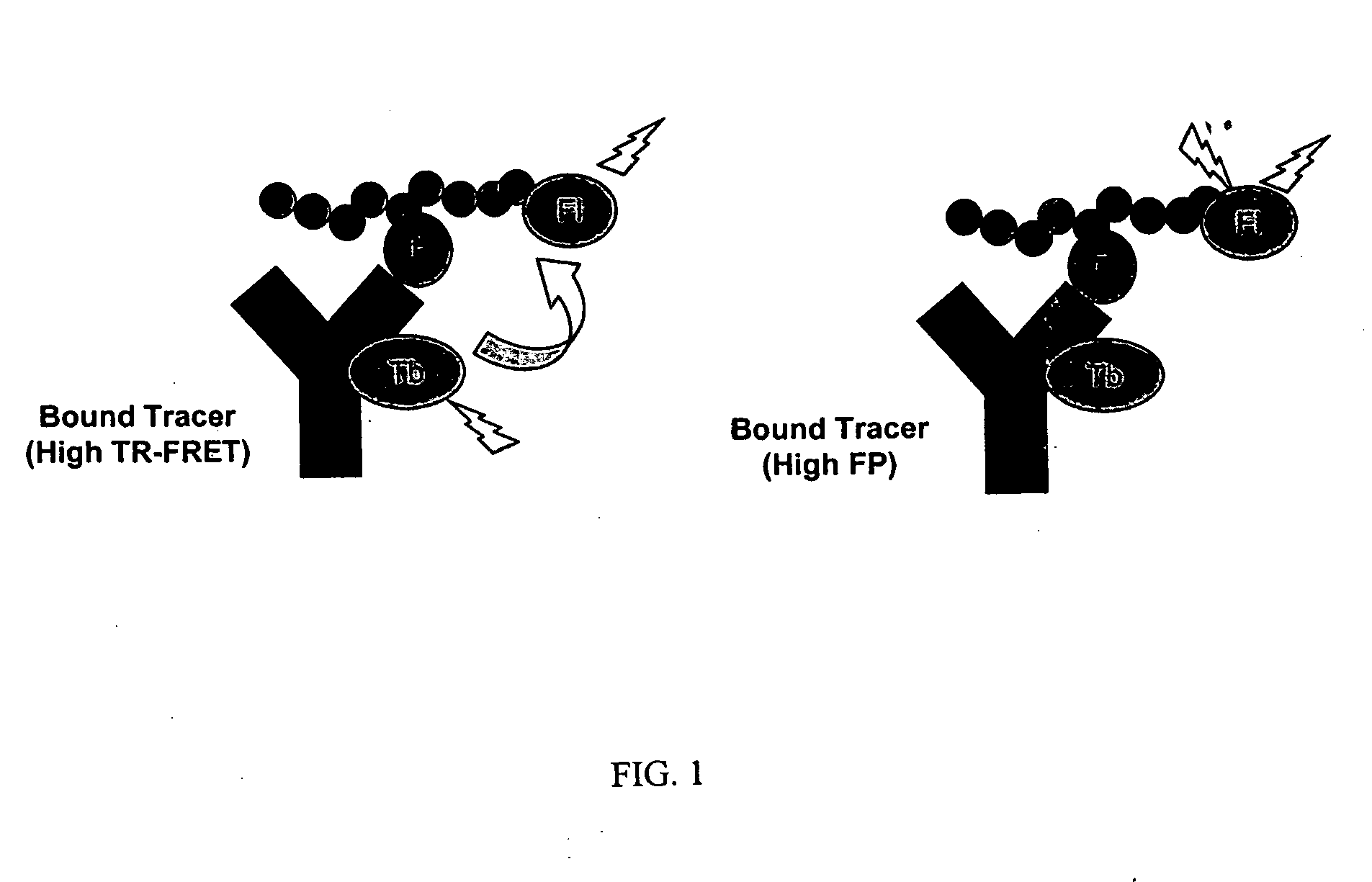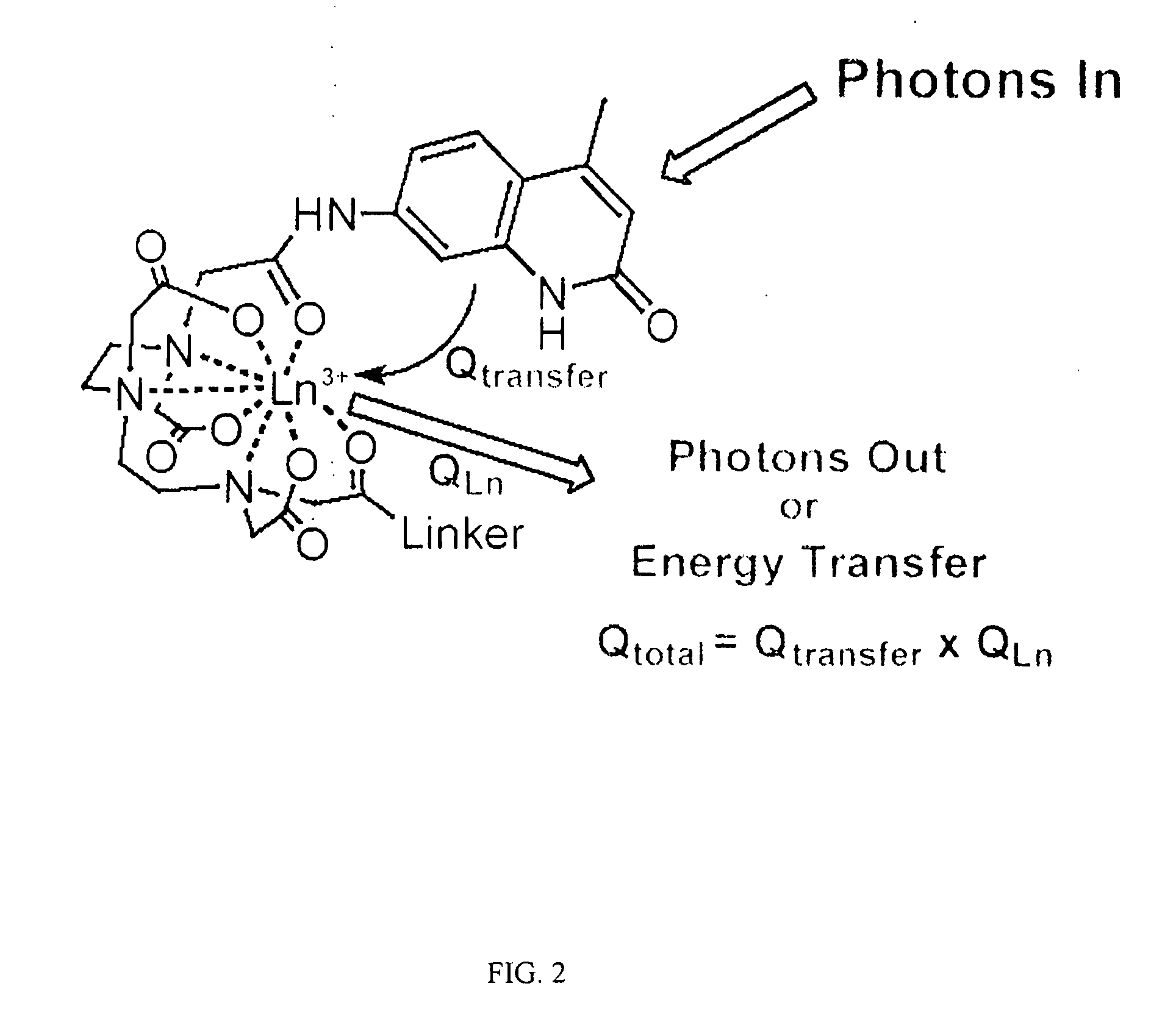Multiplex binding and activity assays
a multi-binding and activity assay technology, applied in the field of assays, can solve the problems of detection of false positives or false negatives in the drug screen, limiting the sensitivity of luminescence-based assays,
- Summary
- Abstract
- Description
- Claims
- Application Information
AI Technical Summary
Benefits of technology
Problems solved by technology
Method used
Image
Examples
example 1
Labeling of Antibody with a Luminescent Metal Chelate
1 mg purified PY72 (anti-phosphotyrosine) IgG antibody, an antibody that preferentially binds amino acid sequences containing phosphorylated tyrosines (e.g., sequences phosphorylated by protein tyrosine kinases (PTKs)) and was dialyzed for 1.5 hours in a 100 mM sodium bicarbonate buffer, pH 9.5, using a 12-14,000 MWCO dialysis membrane. [PY72 hybridoma cells were obtained from the Salk Institute; the immunogen was phosphotyrosine conjugated to KLH. Ascites were produced by Harlan Bioproducts for Science, Indianapolis Ind. Ascites were purified with a protein G column (Pierce). Purified antibody is also available from Covance, Berkeley Calif. (Part # MMS414P).] The antibody was then removed from the dialysis membrane and concentrated to 48.8 uM (7.3 mg / mL) using a Centricon YM50 (Millipore) concentrator. 100 uL of this antibody solution was diluted to 5 mg / ml (33.4 uM) into the labeling reaction which consisted of 10 mM phenyl ph...
example 2
Binding Curve Experiment between Protein Tyrosine Kinase Product Tracer (PTK Tracer) and Anti-PTK Product (PY72) Antibody
A direct binding curve (showing luminescent metal chelate -labeled PY72 antibody binding to fluorescent acceptor labeled tracer) was generated by incubating serial dilutions of the labeled antibody (10 nM to 9.8 pM in two fold dilutions) with 1 nM fluorescent acceptor-labeled tracer (PTK labeled tracer; sequence F-ADE(pY)LIPQQS, where F is fluorescein and pY is a phosphorylated tyrosine, SEQ ID NO:1; note that the tracer is a phosphorylated tyrosine derivative of a protein tyrosine kinase (PTK) substrate) in FP dilution buffer (PanVera, Madison WI part #P2839). After a 30 minute incubation, the fluorescence polarization of each composition in the plate was read on a Tecan Ultra plate reader using a 485 nm excitation filter (20 nm bandpass) and 535 nm emission filters (25 nm bandpass). Data was collected using 10 flashes per well and a 40 μs integration time. The...
example 3
Competition Curve between Labeled Kinase Product Tracer and Unlabeled Kinase Product
A competition curve to show that the disruption of the antibody-tracer interaction could be monitored by both fluorescence polarization and time-resolved RET from the same sample was performed by incubating serial dilutions (10 μM to 19.5 nM in two-fold dilutions) of an0 unlabeled phosphotyrosine-containing peptide competitor (ADE(pY)LIPQQS, where pY is a phosphorylated tyrosine, SEQ ID NO:3) in the presence of 10 nM Th-chelate labeled PY72 antibody and 1 nM labeled PTK labeled tracer, as described above. After a 30 minute incubation, the plate was read on a Tecan Ultra plate reader. Fluorescence polarization was measured using a 485 nm excitation filter (20 nm bandpass) and 535 nm emission filters (25 nm bandpass). Time-resolved RET was measured using a 340 nm excitation filter (35 nm bandpass) and 495 nm (10 nm bandpass) and 520 nm (25 nm bandpass) filters using a 200 μs integration window after ...
PUM
| Property | Measurement | Unit |
|---|---|---|
| Time | aaaaa | aaaaa |
| Time | aaaaa | aaaaa |
| Fraction | aaaaa | aaaaa |
Abstract
Description
Claims
Application Information
 Login to View More
Login to View More - R&D
- Intellectual Property
- Life Sciences
- Materials
- Tech Scout
- Unparalleled Data Quality
- Higher Quality Content
- 60% Fewer Hallucinations
Browse by: Latest US Patents, China's latest patents, Technical Efficacy Thesaurus, Application Domain, Technology Topic, Popular Technical Reports.
© 2025 PatSnap. All rights reserved.Legal|Privacy policy|Modern Slavery Act Transparency Statement|Sitemap|About US| Contact US: help@patsnap.com



